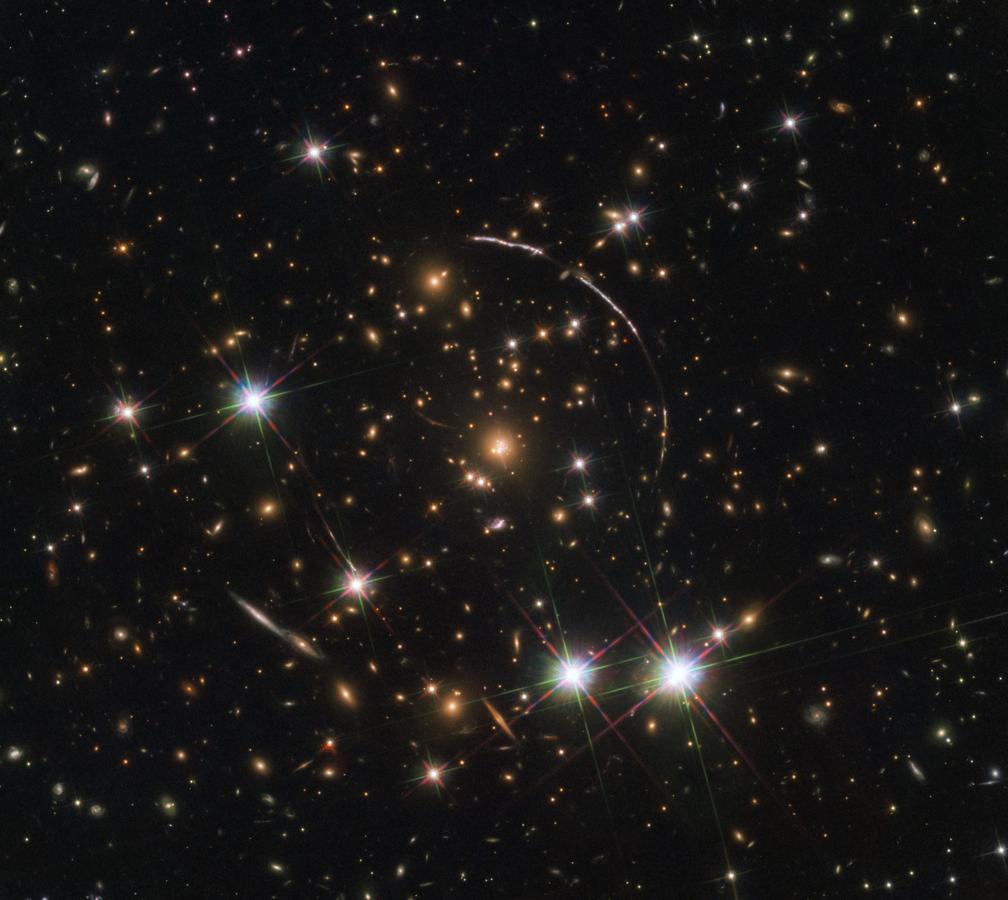Astronomy:Godzilla (star)
Credit: ESA/Hubble, NASA, Rivera-Thorsen et al. | |
| Observation data Equinox J2000.0]] (ICRS) | |
|---|---|
| Constellation | Apus |
| Right ascension | 15h 50m 00.66s[1] |
| Declination | −78° 11′ 09.96″[1] |
| Characteristics | |
| Evolutionary stage | LBV?[1] |
| Astrometry | |
| Absolute magnitude (MV) | -17.3 – -14.8,[lower-alpha 1] <-14.7[lower-alpha 2][1] |
| Details | |
| Radius | 430 – 2,365[1] R☉ |
| Luminosity | 134,000,000 – 255,000,000[1][lower-alpha 3] L☉ |
| Temperature | 15,000 – 30,000[1] K |
| Other designations | |
Godzilla star | |
Godzilla is a variable star in the Sunburst galaxy at redshift z = 2.37 (or 10.9 billion light years from Earth), observed through the gravitational lens PSZ1 G311.65-18.48.[1] It was originally identified in the NW arc as a possible transient event in images taken with the Hubble Space Telescope (HST).[2]
As of October 2022, it is the most luminous star that can be currently observed.[1][3] This is possible because the star is believed to be undergoing an episode of temporary increased luminosity that has lasted at least seven years, combined with an estimated magnification of at least a factor of 2000.
Some spectral features in Godzilla resemble those of other variable stars in the Milky Way Galaxy such as Eta Carinae, suggesting that Godzilla could be close to the end of its life. Godzilla is believed to be going through an episode similar to the Great Eruption of Eta Carinae in the 19th century, during which the star was likely among the brightest in the universe at about 50 million L☉.
The extreme magnification of Godzilla is partially due to a nearby substructure, probably a dwarf galaxy, not seen in the HST images, that is also close to the critical curve of the cluster. This unobserved substructure is believed to be dominated by dark matter.[1]
Godzilla is named after the most famous Kaiju and makes reference to its monstrous nature. Other Kaiju stars include Mothra, which shares many of the characteristics of Godzilla.[4]
See also
Notes
References
- ↑ 1.00 1.01 1.02 1.03 1.04 1.05 1.06 1.07 1.08 1.09 1.10 Diego, J. M.; Pascale, M.; Kavanagh, B. J.; Kelly, P.; Dai, L.; Frye, B.; Broadhurst, T. (2022). "Godzilla, a monster lurks in the Sunburst galaxy". Astronomy and Astrophysics 665: A134. doi:10.1051/0004-6361/202243605. Bibcode: 2022A&A...665A.134D.
- ↑ Vanzella, E.; Meneghetti, M.; Pastorello, A.; Carulla, F. (2020). "Probing the circumstellar medium 2.8 Gyr after the big bang: detection of Bowen fluorescence in the Sunburst arc". Monthly Notices of the Royal Astronomical Society 499 (1): L67–L71. doi:10.1093/mnrasl/slaa163. Bibcode: 2020MNRAS.499L..67V.
- ↑ "Scientists face down 'Godzilla', the most luminous star known". Nature 610 (7930): 10. 6 October 2022. doi:10.1038/d41586-022-03054-3. PMID 36171306. Bibcode: 2022Natur.610T..10..
- ↑ Diego, J. M.; Bangzheng, S.; Yan, H. (2023). "JWST's PEARLS: Mothra, a new kaiju star at z = 2.091 extremely magnified by MACS0416, and implications for dark matter models". Astronomy and Astrophysics 679: 31. doi:10.1051/0004-6361/202347556. Bibcode: 2023A&A...679A..31D.
 |

